



I presently have four professional pantographs, one by Charles Blunt, one by Hall Harding, one by Stanley. and one by Elliott & Sons. The latter two are shown in the Major Maker’s pages for W F Stanley and Elliott Bros. I also have an eidographs by Adie & Son of Edinburgh, retailed by Charles Baker in London, and W F Stanley. Both were used for the same purpose but the eidograph was supposedly more accurate and also more expensive to buy - in fact they were available for hire.
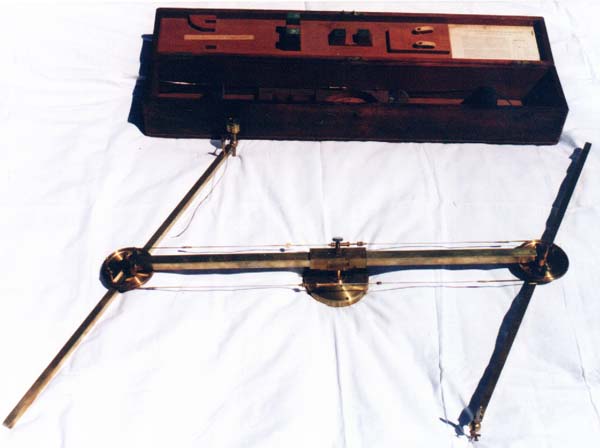
A 30" brass eidograph by Adie & Son of Edinburgh, dating from the third quarter of the nineteenth century. The eidograph was invented by William Wallace, Professor of Mathematics in Edinburgh, in 1821 and the Adie family were the principal makers of the instrument. It was said to be more accurate than the pantograph; it was also more expensive. In J Halden's 1902 catalogue the price of a 30" eidograph was £14 whereas the same size of pantograph was £7 - 10s. At that time this would represent several weeks' wages for a draughtsman and hence it is not surprising that they were also obtainable on daily hire. This example is housed in a fitted mahogany case bearing the retailer, Charles Baker of London's, name in the lid as well as a set of printed instructions on how to set and use it.
I have restored both this and the pantograph below to working order by making new parts as replicas of missing or broken ones.
A 36" brass pantograph (or pentagraph) by Hall Harding & Co dating from the middle of the twentieth century. It was used for copying, enlarging and reducing drawings. It is housed in a fitted mahogany case.
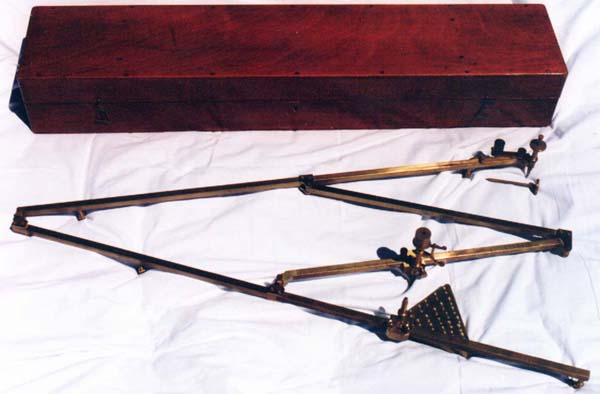


‘Unison’ pantograph made by A Place & Co of London SE14 and sold by Winsor & Newton. This 15” instrument is for enlarging only with set ratios ranging from 1¼ to 8 times. It is made of plated and passivated steel. The left hand end had to be screwed to the drawing board (three screws supplied!), the tracing point is at the junction of the two shorter arms, and a pencil was inserted through the holes at the bottom right. Intended for use by artists and children. Complete with card box and instruction leaflet - never used. Probably 1960s.
Similar simple pantographs were made of wood and today are made of plastic.
Similar simple pantographs were made of wood and today are made of plastic.
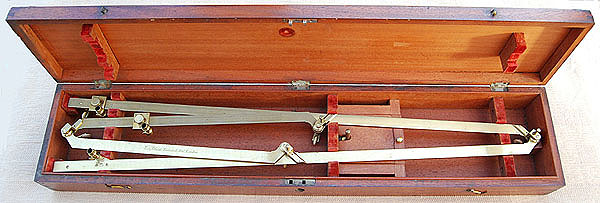

Georgian 26” brass pantograph by Charles Blunt, Tavistock Street, London. The castors are ivory. The lead weight (inside the compartment with a sliding lid in the centre of the mahogany case) is covered in green cloth. It is missing the pencil holder. Charles Blunt is known to have worked at this address from 1814 to 1818. The arms with the sliders are graduated for various size ratios.
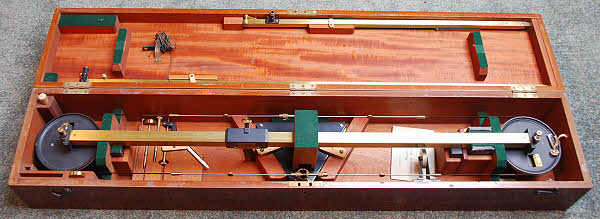
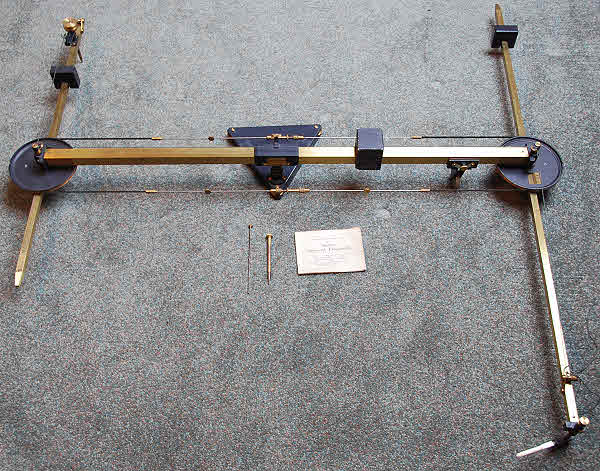
W F Stanley ‘Improved Eidograph’. This is the larger of the two sizes of eidograph produced by Stanley, being the 36 inch model. Stanley made a number of improvements to the design to improve its balance and enable larger reduction and enlargement ratios to be employed. These included the unequal length arms, the additional arm weights, and the jockey wheel. There were also detail improvements to the driving band and tracing point. This example dates from the early 1960s but the improved design dates back to the 19th century.
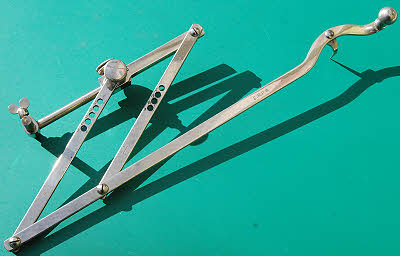
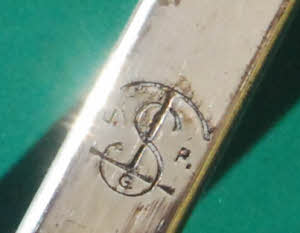
An unusual but sadly incomplete pantograph by an unknown German maker. It was patented in Germany but the patent had expired when this one was made. It is missing the pivot base and drawing points at least. Since the tracing point is fixed at the end of the long arm it can only be used for reduction.
There are nine holes for inserting the drawing point, numbered 1 to 4 on the right hand arm (from bottom to top) and 5 to 9 on the left hand arm. There is a round bar along which a clamp under the top left hand joint can be moved. This is necessary so that once the hole for the drawing point has been selected (to give the desired reduction) the hole, pivot and tracing point can be brought into line, this well known requirement being to avoid the reduced copy being distorted. This method of adjustment I have proved by experiment since I do not have any instructions for this item.
There are nine holes for inserting the drawing point, numbered 1 to 4 on the right hand arm (from bottom to top) and 5 to 9 on the left hand arm. There is a round bar along which a clamp under the top left hand joint can be moved. This is necessary so that once the hole for the drawing point has been selected (to give the desired reduction) the hole, pivot and tracing point can be brought into line, this well known requirement being to avoid the reduced copy being distorted. This method of adjustment I have proved by experiment since I do not have any instructions for this item.
| Early Sets |
| Traditional Sets |
| Later Sets |
| Major Makers |
| Instruments |
| Miscellanea |
| W F Stanley |
| A G Thornton |
| W H Harling |
| Elliott Bros |
| J Halden |
| Riefler |
| E O Richter |
| Kern, Aarau |
| Keuffel & Esser |
| Compasses |
| Pocket compasses |
| Beam compasses |
| Dividers |
| Proportional dividers |
| Pens |
| Pencils |
| Rules |
| Protractors |
| Squares |
| Parallels |
| Pantographs |
| Sectors |
| Planimeters |
| Map Measurers |
| Miscellaneous |
| Materials Used |
| Who made them |
| Who made these |
| Addiator |
| Addimult |
| Other German |
| USA |
| Miscellaneous |
| Microscopes |
| Barometers |
| Hydrometers & Scales |
| Pedometers |
| Surveying Instruments |
| Other instruments |
| Workshop Measuring Tools |
| Catalogues & Brochures |
| Micrometers & Verniers |
| Engineering rules and gauges |
| Wood rules & calipers |
| Dial gauges & miscellaneous |